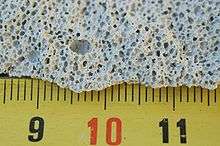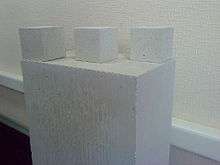Autoclaved aerated concrete


Autoclaved aerated concrete (AAC), also known as autoclaved cellular concrete (ACC), autoclaved lightweight concrete (ALC), autoclaved concrete, cellular concrete, porous concrete, Aircrete, Hebel Block, and Ytong is a lightweight, precast, Foam concrete building material invented in the mid-1920s that simultaneously provides structure, insulation, and fire- and mold-resistance. AAC products include blocks, wall panels, floor and roof panels, cladding (facade) panels and lintels.[1]
History
AAC was perfected in the mid-1920s by the Swedish architect and inventor Dr. Johan Axel Eriksson,[2][3] working with Professor Henrik Kreüger at the Royal Institute of Technology.[2][3] It went into production in Sweden in 1929 in a factory in Hällabrottet and quickly became very popular. Siporex was established in Sweden in 1939 and presently licenses and owns plants in 35 locations around the world. In the 1940s, the trademark Ytong was introduced, and was often referred to as "blue concrete" in Sweden due to its blueish tinge. This version of Ytong was produced from alum shale, whose combustible carbon content made it beneficial to use in the production process. The competing concrete brand Siporex produced in Tuzla, Bosnia, used other raw materials. "Ytong" acquired Siporex and today produces "Siporex" under "Ytong" brand in Tuzla, Bosnia factory. Unfortunately, the slate deposits used for Ytong also contain uranium, which makes the material give off radioactive radon gas to the building. In 1972, the Swedish Radiation Safety Authority pointed out the unsuitability of a radon-emitting construction material, and the use of alum slate in the production of Ytong ceased in 1975. Ytong produced after 1975 has used raw materials without the uranium content.
AAC production in Europe has slowed down considerably, but the industry is growing rapidly in Asia due to strong demand in housing and commercial space. China, Central Asia, India, and the Middle-East are the biggest in terms of AAC manufacturing and consumption.[4]
Uses
AAC is a highly thermally insulating concrete-based material used for both internal and external construction. Besides AAC's insulating capability, one of its advantages in construction is its quick and easy installation, because the material can be routed, sanded, or cut to size on site using standard carbon steel power tools.
AAC is well suited for urban areas with high rise buildings and those with high temperature variations. Due to lower density, high rise buildings constructed using AAC require less steel and concrete for structural members. Requirement of mortar for laying AAC blocks is reduced due to less number of joints. Similarly material required for rendering is also lower due to dimensional accuracy of AAC. Better thermal efficiency of AAC makes it suitable for use in areas with extreme temperature as it eliminates need for separate materials for construction and insulation leading to faster construction and savings.
Even though regular cement mortar can be used, most of the buildings erected with AAC materials use thin bed mortar in thicknesses around ⅛ inch, depending on the national building codes. AAC materials can be coated with a stucco or plaster compound to guard against the elements, or covered with siding materials such as brick or vinyl.
Manufacturing
Unlike most other concrete applications, AAC is produced using no aggregate larger than sand. Quartz sand, calcined gypsum, lime (mineral) and/or cement and water are used as a binding agent. Aluminum powder is used at a rate of 0.05%–0.08% by volume (depending on the pre-specified density). In some countries, like India and China, fly ash generated from thermal power plants and having 50-65% silica content is used as an aggregate.
When AAC is mixed and cast in forms, several chemical reactions take place that give AAC its light weight (20% of the weight of concrete) and thermal properties. Aluminum powder reacts with calcium hydroxide and water to form hydrogen. The hydrogen gas foams and doubles the volume of the raw mix creating gas bubbles up to 3mm (⅛ inch) in diameter. At the end of the foaming process, the hydrogen escapes into the atmosphere and is replaced by air.
When the forms are removed from the material, it is solid but still soft. It is then cut into either blocks or panels, and placed in an autoclave chamber for 12 hours. During this steam pressure hardening process, when the temperature reaches 190° Celsius (374° Fahrenheit) and the pressure reaches 8 to 12 bar, quartz sand reacts with calcium hydroxide to form calcium silicate hydrate, which gives AAC its high strength and other unique properties. Because of the relatively low temperature used AAC blocks are not considered fired brick but a lightweight concrete masonry unit. After the autoclaving process, the material is ready for immediate use on the construction site. Depending on its density, up to 80% of the volume of an AAC block is air. AAC's low density also accounts for its low structural compression strength. It can carry loads of up to 8 MPa (1,160 PSI), approximately 50% of the compressive strength of regular concrete.[5]
Since 1980, there has been a worldwide increase in the use of AAC materials. New production plants are being built in Australia, Bahrain, China, Eastern Europe, India, Israel, and the USA. AAC is increasingly used by developers, architects, and home builders worldwide.
Advantages
AAC has been produced for more than 70 years, and it offers several significant advantages over other cement construction materials, one of the most important being its lower environmental impact.
- Improved thermal efficiency reduces the heating and cooling load in buildings.
- Porous structure allows for superior fire resistance.
- Workability allows accurate cutting, which minimizes the generation of solid waste during use.
- Resource efficiency gives it lower environmental impact in all phases of its life cycle, from processing of raw materials to the disposal of waste.
- Light weight saves cost & energy in transportation, labor expenses, and increases chances of survival during seismic activity.[6]
- Larger size blocks leads to faster masonry work.
- Reduces the cost of the project.
- Environmentally Friendly: When used, it helps to reduce at least 30% of environmental waste as opposed to going with traditional concrete. There is a decrease of 50% of greenhouse gas emissions. When possible, using autoclaved aerated concrete is a better choice for the environment.
- Energy Saver: It is an excellent property that makes it an excellent insulator and that means the interior environment is easier to maintain. When it is used, there is usually not a need for any supplementary insulation.
- Great Acoustics: When you think of concrete, you do not consider it to be excellent for acoustics, however autoclaved aerated concrete has excellent acoustic performance. It is able to be used as a very effective sound barrier.
- Fire Resistant: Just like with regular concrete, ACC is fire resistant. This material is completely inorganic and not combustible.
- Great Ventilation: This material is very airy and allows for the diffusion of water. This will reduce the humidity within the building. ACC will absorb moisture and release humidity; this helps to prevent condensation and other problems that are related to mildew.
- Non-Toxic: There are no toxic gases or other toxic substances in autoclaved aerated concrete. It does not attract rodents or other pests nor can it be damaged by such.
- Lightweight: Concrete blocks that are made out of ACC weigh about one-fifth of typical concrete. They are also produced in sizes that are easy to handle for quick construction.
- Accuracy: The panels and blocks made of autoclaved aerated concrete are produced to the exact sizes needed before they even leave the factory. There is less need for on-site trimming. Since the blocks and panels fit so well together, there is a reduced use of finishing materials such as mortar.
- Long Lasting: The life of this material is extended because it is not affected by harsh climates or extreme changes in weather conditions. It will not degrade under normal climate changes either.
- Quick Assembly: Since it is a lightweight material and easy to work with, the assembly is much quicker and smoother.
References
- ↑ "Products specifications - AIRCRETE". aircrete-europe.com.
- 1 2 Hebel: The History of AAC at the Wayback Machine (archived November 4, 2010)
- 1 2 Swedish Association of Historical Buildings: Pioneering work in the early days of concrete - history 1890–1950 (from Byggnadskultur issue 4/2004) (Swedish)
- ↑ "AAC India".
- ↑ "Sorry! BuildingGreen.com encountered an error.". buildinggreen.com. horizontal tab character in
|title=at position 8 (help) - ↑ "AAC India - Advantages of using AAC".
External links
- Portland Cement Association's information on construction with AEC/ACC
- Aircrete Products Association
- Masonry Magazine, June 2008
- Toolbase.org